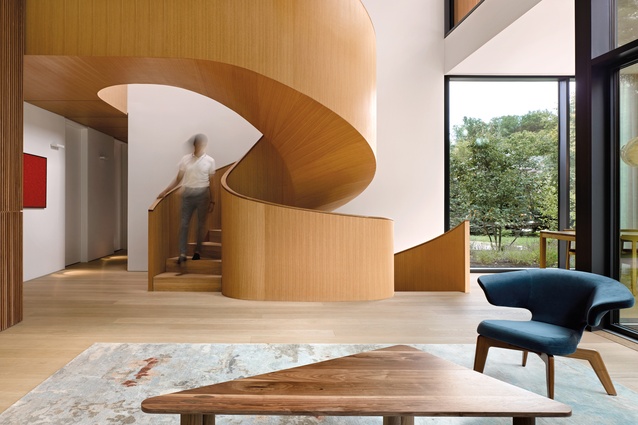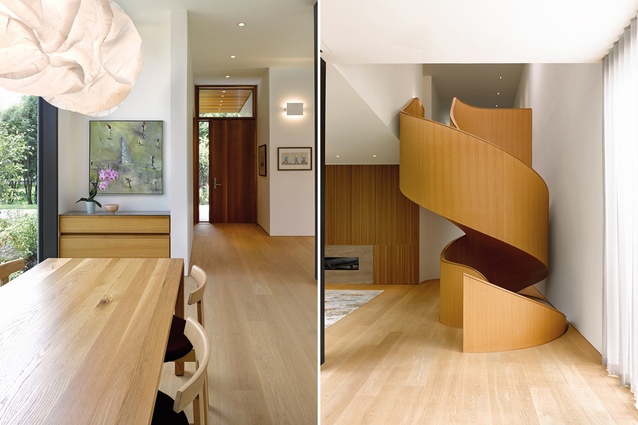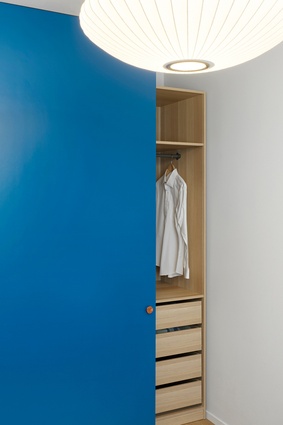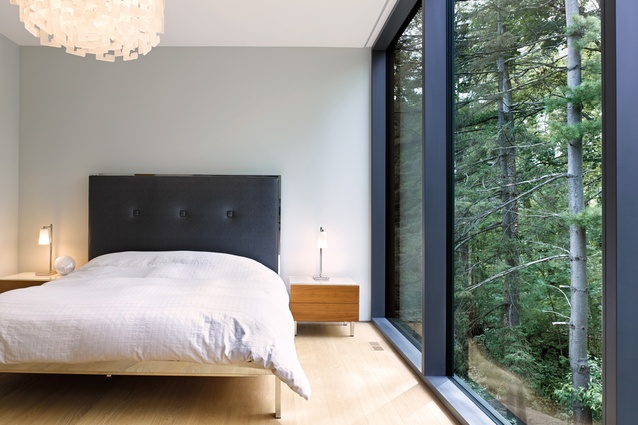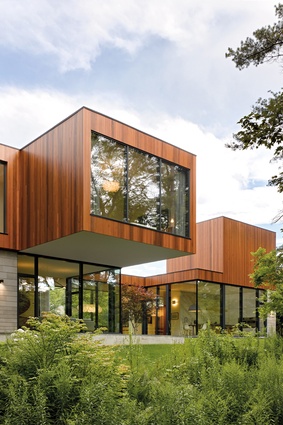In perfect unison: Ancaster Creek Home
A couple and their extended family share a home made up of two houses that are separate yet delightfully stitched together.
As architect Betsy Williamson describes, for a home that needed to manage intergenerational living, the client brief was refreshingly succinct. “The client is a couple and the parents of one of the members of the couple are elderly and needed an accessible apartment effectively within the home so that they could all live together. It was also important that all the major rooms of the house had views of the creek.”
Located alongside Ancaster Creek in Ontario, this L-shaped building, designed by Toronto’s Williamson Williamson Inc., combines two homes for two couples. The components of each are relatively ordinary, yet extraordinary when combined.
The house was first conceptualised as two long rectangular blocks or bars: one for the client couple and one for the parents. Williamson explains: “The house is two bars and each bar has the full programme of a home – kitchen, living, dining, bedrooms and bathrooms. One bar is parallel to the creek and that’s the main part of the house… the other bar is perpendicular to the creek and that’s for the parents. And then they stack in the corner.”
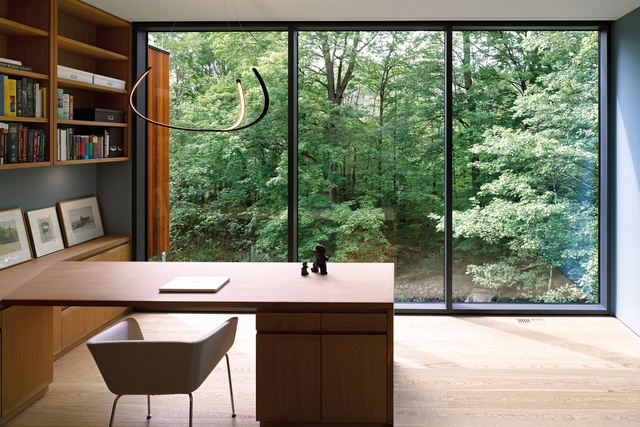
At the overlap, a beautiful timber-clad spiral, curved staircase connects the living room to the second-floor master suite, creating a stunning vertical moment in the otherwise very horizontal spaces. The timber staircase is beautiful and, as Williamson describes, “It’s structured in wood. It has only a very, very thin metal plate. That metal plate works only because it’s tied together with timber treads and risers. It’s a gorgeous material.”
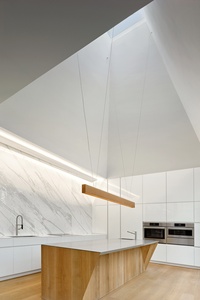
The main residence runs parallel to Ancaster Creek. The kitchen, living room and dining room are on the lower floors, with a separate private master suite on the level above. The kitchen, with its back-painted glass and polished Calacatta marble slabs, works to reflect the outside natural surroundings.
Under the double-height, pyramidal kitchen ceiling sits a simple, flat-sawn, solid-oak kitchen island. A small upper storey gently cantilevers out towards the creek, with bedroom, living room, library and grey marbled bathroom all included. The light-filled bedroom stretches out towards the best views of the creek.
Running perpendicular, the parents’ home occupies the ground floor only with the living and dining spaces facing the creek and benefiting from the serene views. The series of spaces is laid out as a single-levelled accessible apartment, with some added design features to accommodate aging residents. A second bedroom and bathroom are near, but isolated towards the garage, potentially for a live-in nurse or guest.
But the success of these spaces is not in their separation but in their connection. The homes are “not exclusively separated but [have] spaces that are generous enough to be shared. Then everyone has a place that they can go to… retreat.”
The verticality of the upper storey is emphasised by its thin cedar boards, while the lower storey is anchored to the ground with locally quarried limestone, which stretches out horizontally. The interior and exterior languages of the home are intertwined, and are connected by this local timber and stone palette.
“The house feels very warm and comfortable… [we try] to be fairly abstract in the design process but not abstracting it to the point where it becomes too cool of a space. So, we bring warmth into all the spaces, whether it be through connection to landscape or materiality.”
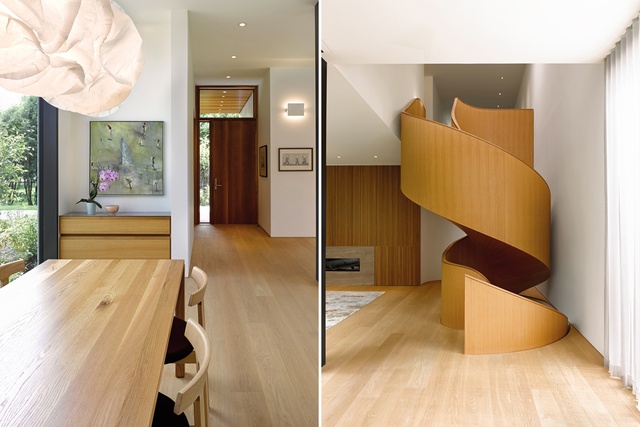
Williamson found the three-dimensional development of the project most enjoyable. “The kitchen has a pyramidal ceiling [which] is probably 22 feet tall… in order to balance the house, we really needed to create a double height on the left-hand side. And so that developed with coming into a space that was slightly unexpected; you’re almost not occupying one level of floor but you have moments where it compresses and then expands in section.”
A particularly successful space for the client is the dining space: a space that would not have eventuated if not insisted on by the architects. The dining-room space is a glazed link pinched between the landscape of the front and rear of the property, which leads through to the shared living room.
A timber wall, representative of the exterior cladding, and a lovely honed travertine fireplace complete the series of spaces. “We made this little space that you have to pass through a lot because [the clients] said they didn’t want a room in the house that they never use. They told us the space is so great and that they just like to sit there; so I thought that was kind of a really transformational, successful piece of the house.”
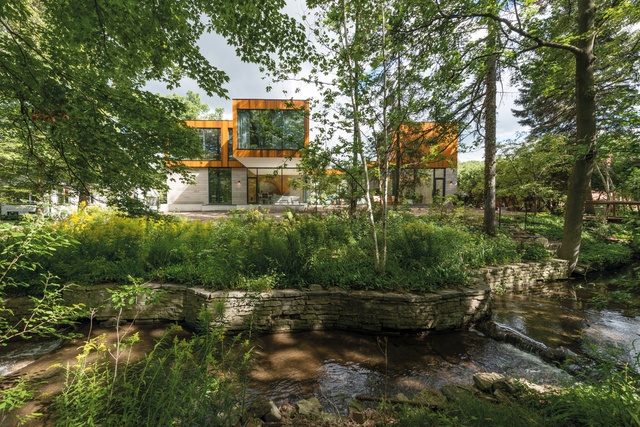
The final product creates a set-up for living that allows independence along with all the benefits of proximity. It does this while being beautiful also. Williamson describes her pride in the project, fundamentally this way: “First of all, the owners totally love it, which is really important”.
And the project was completed without compromising Williamson’s values. “We endeavour to do projects that are intellectually and academically ambitious that also really work for our clients… we are trying to balance the kind of intellectual rigour that we bring to the work with actually being a building practice.” Although it is not the norm, this house shows that there is a lot of value in an extended family being able to live together. There’s also a lot of value in being able to create a beautiful home that can successfully accommodate that.
This article first appeared in Urbis magazine.


